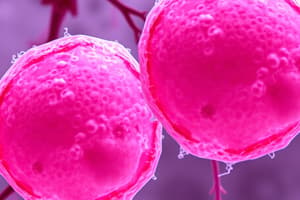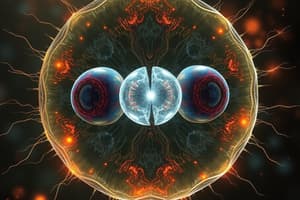Podcast
Questions and Answers
What is mitosis and why is it important for living organisms?
What is mitosis and why is it important for living organisms?
Mitosis is a type of cell division that results in two daughter cells with the same number of chromosomes as the parent cell. It is important for living organisms because it allows for growth, repair, and replacement of cells.
Describe the steps of mitosis and explain what happens during each phase.
Describe the steps of mitosis and explain what happens during each phase.
The steps of mitosis are prophase, metaphase, anaphase, and telophase. During prophase, the chromosomes condense and the nuclear envelope breaks down. In metaphase, the chromosomes line up at the center of the cell. In anaphase, the sister chromatids separate and move to opposite ends of the cell. In telophase, the nuclear envelope reforms and the chromosomes decondense.
What are the similarities and differences between mitosis and meiosis?
What are the similarities and differences between mitosis and meiosis?
Mitosis and meiosis are both types of cell division, but they have some key differences. While mitosis produces two daughter cells with the same number of chromosomes as the parent cell, meiosis produces four daughter cells with half the number of chromosomes. Additionally, mitosis is involved in growth and repair, while meiosis is involved in the formation of gametes for sexual reproduction.
Flashcards are hidden until you start studying




